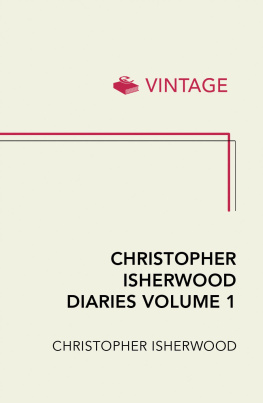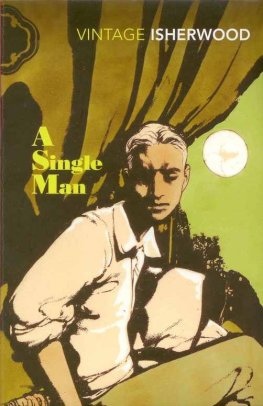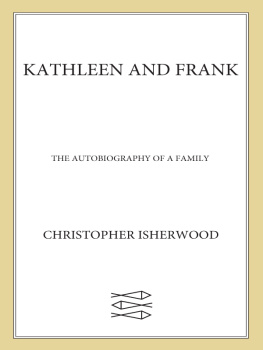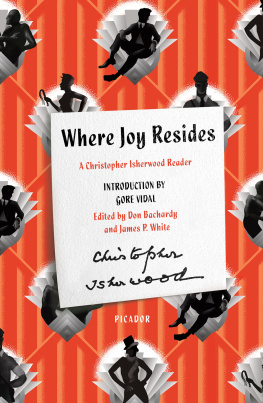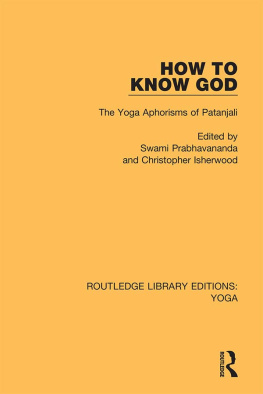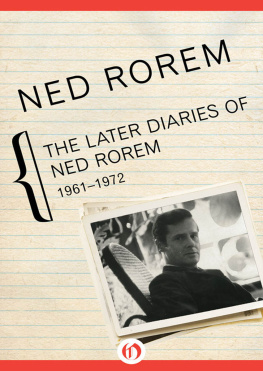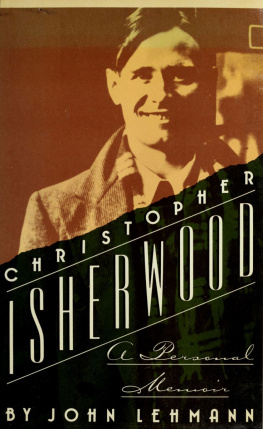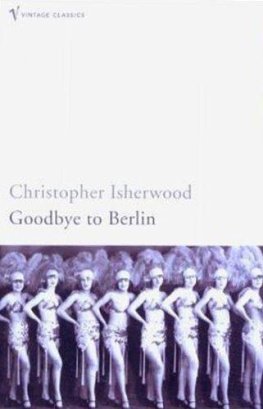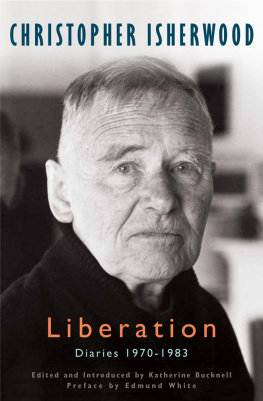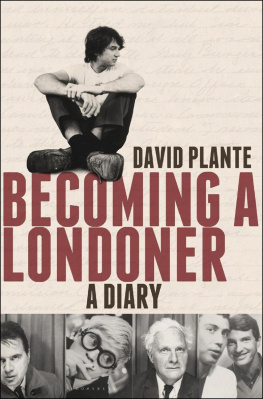Contents
About the Book
In 1939 Christopher Isherwood and W. H. Auden emigrated together to the United States. In spare, luminous prose these diaries describe Isherwoods search for a new life in California; his work as a screenwriter in Hollywood, his pacifism during World War II and his friendships with such gifted artists and intellectuals as Garbo, Chaplin, Thomas Mann, Charles Laughton, Gielgud, Olivier, Richard Burton and Aldous Huxley.
Throughout this period, Isherwood continued to write novels and sustain his literary friendships with E. M. Forster, Somerset Maugham, Tennessee Williams and others. He turned to his diaries several times a week to record jokes and gossip, observations about his adopted country, philosophy and mystical insights. His devotion to his diary was a way of accounting for himself; he used it as both a discipline and a release.
About the Author
Christopher Isherwood (19041986) was one of the most celebrated writers of his generation. He left Cambridge without graduating, briefly studied medicine and then turned to writing his first novels, All the Conspirators and The Memorial. Between 1929 and 1939 he lived mainly abroad in Europe, spending four years in Berlin and writing the novels Mr. Norris Changes Trains and Goodbye to Berlin on which the musical Cabaret was based. He wrote three plays with W. H. Auden and emigrated with him to America in 1939. Auden settled in New York and Isherwood went on to California where he became a successful screenwriter. He took U.S. citizenship in 1946, and wrote another five novels, including Prater Violet, Down There on a Visit and A Single Man. He also wrote a travel book about South America and a biography of the Indian mystic Ramakrishna. In the late 1960s and the 1970s he turned to autobiography Kathleen and Frank, Christopher and His Kind, My Guru and His Disciple and published October, one month of his diary with drawings by Don Bachardy.
Katherine Bucknell is editor of Christopher Isherwoods The Sixties: Diaries Volume Two: 19601969 and Lost Years: A Memoir 19451951, and of W. H. Audens Juvenilia: Poems 19221928. She is co-editor of Auden Studies and a founder of The W. H. Auden Society. She is also the author of three novels.
www.katherinebucknell.com
Also by Christopher Isherwood
Novels
All the Conspirators
The Memorial
Mr. Norris Changes Trains
Goodbye to Berlin
Prater Violet
The World in the Evening
Down There on a Visit
A Single Man
A Meeting by the River
Autobiography and Diaries
Lions and Shadows
Kathleen and Frank
Christopher and His Kind
My Guru and His Disciple
October (with Don Bachardy)
The Sixties: Diaries Volume Two: 19601969
Lost Years: A Memoir: 19451951
Biography
Ramakrishna and His Disciples
Plays (with W. H. Auden)
The Dog Beneath the Skin
The Ascent of F6
On the Frontier
Travel
Journey to a War (with W. H. Auden)
The Condor and the Cows
Collections
Exhumations
Where Joy Resides
Chronology
1904 August 26, Christopher William Bradshaw Isherwood, first child of Frank Bradshaw Isherwood and Kathleen Bradshaw Isherwood (ne Machell Smith), born at Wyberslegh Hall, High Lane, Cheshire, on the estate of his grandfather, John Bradshaw Isherwood, squire of nearby Marple Hall.
1908 February 28, moves to Strensall near York following his fathers regiment; November 9, moves to Frimley near Aldershot following his fathers regiment.
1909 Dictates a story, The Adventures of Mummy and Daddy.
1910 His father begins teaching him to read and write.
1911 Begins attending local school; October 1, brother Richard Graham Bradshaw Isherwood born; November 27, father leaves to join his regiment in Limerick, Ireland.
1912 January, moves with his mother and baby brother to Limerick; September 28, sees first film.
1914 May 1, arrives at his preparatory school, St. Edmunds, Hindhead, Surrey as a nine-year-old boarder; August 4, Britain declares war on Germany and Isherwoods father receives mobilization orders; August 14, Frank Isherwoods regiment leaves Limerick for England; August 24, Isherwood and his mother and brother move back to Marple; September 8, the regiment leaves for France; Isherwood returns to St. Edmunds; November 2829, his father visits him at school while on leave.
1915 February 28, Isherwoods father visits him at school for the last time; March, Isherwood gets measles followed by pneumonia, leaves school to convalesce; May 8 or 9, Frank Isherwood evidently wounded at Ypres, probably killed; June 24, Kathleen Isherwood receives Franks identity disk, apparently confirming his death; September 17, Isherwood returns to school, having missed more than a term.
1917 January 1, Isherwood begins keeping a diary; he records walking with W. H. Auden at school; March 18, ill with German measles, remains at school during start of holidays with Auden and a few other boys.
1918 January 1, Isherwood begins a new diary, lasting until September; December 19, leaves St. Edmunds having won numerous prizes.
1919 January 17, arrives at Repton, his public school, near Derby; October 10, Richard Isherwood starts school at Berkhamstead; November 30, Isherwood confirmed as Anglican.
1921 Winter, joins G. B. Smiths history form at Repton where he meets Edward Upward; November, Kathleen Isherwood moves with her mother to 36 St. Mary Abbots Terrace in West Kensington, London; December, Isherwood sits scholarship exam at Cambridge with Upward and wins 40 exhibition to Corpus Christi College; Richard Isherwood leaves his school.
1922 January 18, Richard Isherwood starts school again in London, at Norland Place; June 23, Isherwood wins English Essay Prize, History Prize, and Literature Prize at Repton speech day; July, wins form prize; summer, writes two chapters of a school novel; September, begins last term at Repton; December, wins 80 scholarship to Corpus Christi College, Cambridge.
1923 Lives at home in London; writes three chapters of a school novel; April 10July 3, studies French in Rouen; begins writing a novel called Lions and Shadows; October 10, goes up to Corpus Christi, renews close friendship with Edward Upward.
1924 Around this time, Isherwood and Upward start keeping diaries and begin to invent Mortmere; Isherwood writes various shorts stories; summer, achieves 2:1 in Mays exams.
1925 January, finishes his novel, now titled Christopher Garland; June 1, Cambridge Tripos exams begin; June 11, Isherwood returns to London; June 18, summoned to Cambridge to explain his joke Tripos answers and withdraws; August, takes job as secretary to Andr Mangeots string quartet; December, meets W. H. Auden and renews prep school friendship.
1926 January, begins writing another novel, The Summer at the House; Easter, begins Seascape with Figures (first version of All the Conspirators), completed by autumn.
1927 January 4, moves out of his mothers house at St. Mary Abbots Terrace into a friends empty lodgings in Redcliffe Road; January 24, takes job as private tutor; autumn, returns to his mothers house; decides to go to medical school.
Next page
